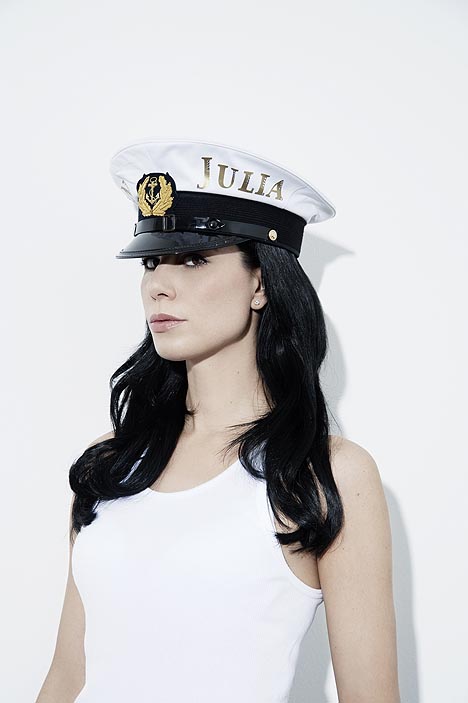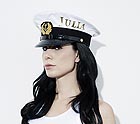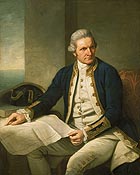
translated and summarized by: Liz Wollner-Grandville,
English summary June 14 - 19
Deichtorhallen
Julia Stoschek Collection. I want to see how you see
16.04.10 - 25.07.10
Mrs. Captain and her art freight
Collecting contemporary art permanently generates new questions on positions and theories of artists. The process-oriented exhibition “I want to see how you see” also mirrors the attentiveness and openness of the collector and founder of the collection.
Born in 1975 in Cobourg, Julia Stoschek - shareholder of the Brose-Group, an automobile parts supplier - devotes most of her time to the collection. Since 2004, she has been one of the board members of the KW-Institute for Contemporary Art in Berlin and in 2007, was appointed to the Trustee Committee on Media and Performance Art of the New York Museum of Modern Art as a member of the acquisition commission. During the last eight years, she has purchased 420 works created by renowned international artists for her own private collection, including innovative works by a younger and lesser-known generation. The company headquarters are located in a closed-down factory, which was reopened in 2007 as a private museum after being modified by the Berlin-based architects Kühn Malvezzi. The collector describes herself as an “eye person”, a smart understatement in view of the complexity of her collection and not so much an aesthetic inclination. Essential art productions created by women in the USA, Europe, and Africa over the course of the last four decades play an important role in Stoschek’s collection. For the first time, 65 works by 54 artists are presented outside Düsseldorf at the Große Deichtorhallen.
The new director, Dirk Luckow, created an exhibition concept in which the collector performed as an advertising medium. On the left side of the main entrance, a 2.5m x 3.5 m banner depicts Julia Stoschek in a white tank top and with a captain’s hat, photographed by Gumppenberg & Bienert. The spectrum of the exhibition includes film, video, and photography dealing with topics such as pain, transformation, and utopia, as well as political and social changes. Among the works are “Shoot” (1971) by Chris Burden and the 14-minute video-statement “Art must be beautiful / Artist must be beautiful” (1975) by Marina Abramovic, as well as works by Vito Acconci, Doug Aitken, Björk, Monica Bonvicini, Robert Boyd, Gordon Matta-Clark, Patty Chang, Thomas Demand, Nathalie Djurberg, Andreas Gursky, Christian Jankowski, Terence Koh, Klara Liden, Alex McQuilkin, Bruce Nauman, Tony Oursler, Aura Rosenberg, Martha Rosler, Thomas Ruff, Christoph Schlingensief, Steina Vasulka und Franz West with „L28“ (2006).The exhibition title was taken from Pipilotti Rist’s video created in 2003.
The walk-in installation “2-Dimensional Mirror Labyrinth” (2006) by Jeppe Hein, the three canal video by Isaac Julien “True North” (2004) which is projected onto three screens, as well as the two sculptures "Intstandvokati" and "Sondzela” (both 2008) created by Nandipha Mntambo are definitely worth seeing. Of not is the installation “Killing Machine” (2007) by Janet Cardiff and Georges Bures Miller, which, however, is not exhibited at the Deichtorhallen. The installation, which deals with the death penalty and Frank Kafka’s “The Penal Colony”, is on permanent loan to the MoMA.
The 150-page exhibition catalogue is especially recommended for those who have less knowledge about media technology positions spanning from the 1970’s to the present day. The huge effort is a critical statement directed against museums and art associations that are under pressure on account of the continuously rising costs and simultaneously have become risk avers and lower their sights regarding sensitive topics. We live in a more or less educated information society, which is increasingly losing itself in its search for the meaning of life in a globalized world. Private collections are essential documentations on the interaction of outside reflections as well as self-reflection of contemporary trends.
By Leon Gumil Hainzl
Deichtorhallen
20095 Hamburg, Deichtorstraße 1 + 2
www.deichtorhallen.de
Museum für Völkerkunde
James Cook
12.05.10 – 13.09.10
Not a continent – but enlightenment
Following the museums-co-operation for the exhibition “Sitting Bull”, the Museum for Ethnology in Vienna is again co-operating with other museums – this time with its counterparts in Bonn and Berne. The exhibition “James Cook and the Discovery of the South Pacific” focuses on the merits of the three world sailing tours under the leadership of James Cook -the surveyor, navigator and cartographer (1728 – 1779) and his companions.
Today one knows that enlightenment would have most probably taken a different turn without some of these new findings, which revolutionized the western view of life. This change of view is symbolized with two globes - one placed at the beginning, and one at the end, of the exhibition. And they differ greatly from each other: one of them didn’t yet include the southern continent. The first journey’s official mission was to observe Venus’ passage, but there was also a secret mission: to discover the (presumed) southern continent. The “discovery” of the non-existence of the terra australis incognita was sensational. The “preparation” of the “curiosities”, the material legacy of the journeys in addition to the evaluation and publication, took two (!) centuries to assemble. The award-winning exhibition catalogue offers lots of details and is highly recommendable.
The exhibition centres on a treasure of the Museum of Ethnology, which was neglected by the public until now. Thanks to the interest in ethnology of Emperor Franz I, the museum owns the second largest Cook-collection in the world - many of the collection's essential pieces were acquired at an auction in England in 1806.
Among the members of the English crew were “sea dogs” as well as international scientists; a combination, which proved that networking among scholars was already a given at that time - and the success speaks for itself.
Botanists, astrologists and artists among Cook's crew created the lasting South Pacific image. 140 of the 955 botanical and 337 zoological drawings made by the painter Sydney Parkinson during the first journey still exist. The landscape painter William Hodges created the so-called “landing painting”: a kind of propaganda tool. The profiles of the coastline were meant to be recognizable for seafarers. The events were idealised and narrated with classic captions - the majority of the 40 paintings were created in a London studio; the 40 landscape and boat drawings as well as the 50 portrait and figure sketches during the second journey. The Swiss painter John Webber joined the third journey and created 3,330 drawings and 20 oil paintings. The Bernese owe their collection to him.
By Maria-Gabriela Marinkowic
Museum für Völkerkunde
1010 Vienna, Neue Burg
www.ethno-museum.ac.at
Alte Pinakothek
Arnulf Rainer – The Overpainter
10.06.10 – 05.09.10
“Rubens’ wife simply winked at me”
“Once a week I have to be alone, I lock myself up, walk around my studio and clean the floor, and then, slowly, an idea for the next brushstroke emerges. And then I paint for the rest of the day, as long as I can. Nobody is allowed to disturb me and I all I have is Green Tea”. Rarely has Arnulf Rainer spoken so openly about his work, seemed so focused on his motives and his path, as if he were looking back at what was really important to him: his first overpaintings, the series of “Face Farces”, the death masks, the crosses. His first overpaintings were created in 1953, but mainly because Arnulf Rainer didn’t have enough money to buy canvases and therefore bought paintings at flea markets and painted over them. He has stuck to this principle from that day to this - as his recent works presented at the Alte Pinakothek in Munich prove. He overpainted works by Boucher, Giorgione, Rubens and Velàsquez. No, he was not aware of having invented a unique aesthetic principle back in the 1950’s. “I didn’t even notice what I had done – it was the others, the critics, who coined the expression “overpainting”. I was relatively naïve and thought this is not a category, but only a superficial technological process born out of a lack of money. But then I became increasingly choosy regarding the motives.” One could also see overpainting as a comparison to other artistic abilities. A competition to see if one withstands the other, and vice versa. “No”, I never had the feeling that I surpass the other”, for example Rubens, “ The Honeysuckle Bower”, a self-portrait with his first wife, Isabella Brant, that is something I cannot surpass. All I can do is shift, transform or add a different expression to the painting.” This sounds modest and not at all like Rainer. Nevertheless, even his most recent paintings have their own strength. Their colours are extraordinary. In his most recent paintings, all based on old masters from the Alte Pinakothek, he is not concerned with his relationship to certain artists, but only with the faces, which show up in their works. “Isabella Brant simply winked her eye at me. And then I thought she wants to be depicted in the Rainer-style.”
The selection of paintings presented at the Alte Pinakothek is outstanding, with a major part of the works originating from the artist’s own collection. The 80-year old is not easily embarrassed, unless he is asked to talk about religiosity, which he sensed in works by Giotto or Cimabue. Change of topic: what does he think about the recent discussion on brain doping or neuro-enhancement, especially as someone who experimented with LSD under medical supervision? Should one provide medicine to healthy people to increase their performance, maximize their creativity or enhance their personality? “Only if a physician is around. Regarding my LSD experience: the Max Plank Institute conducted a test series in the 1960’s. The doctors wanted to research what effect LSD had on artists and their work. But I must admit that I was not able to work with this drug. Maybe my fantasy and my creativity were enhanced, but it wasn’t necessary.” More important for his work are enough space, skylight, and his “colour trolley”. He pulls it through his studio in Enzenkirchen while he continues to overpaint women’s faces, some of them are movie stars, but some are unknown women. Supposedly all of them winked their eye at him.
By Astrid Mayerle
Alte Pinakothek
80333 Munich, Barer Strasse 27
www.pinakothek.de/alte-pinakothek
Museum Liaunig
Tradition and Avant-garde – Art in Austria 1945 – 1980
01.05.10 – 31.10.10
Conventional, but well combined
What can one expect from an exhibition with the title “Tradition and Avant-garde – Art in Austria 1945 – 1980”? At first one would assume: nothing new, lots of – excuse me – provincial art. But the exhibition, curated by Peter Baum at the Museum Liaunig in Neuhaus /Suha, has more to offer.
Although the 350 works were grouped rather conventionally, one rarely sees them so concentrated and in such abundance. And there are many ingenious combinations: early works by Maria Lassnig with an atypical painting by Jürgen Messensee or a sculpture by Josef Pillhofer juxtaposed with a painting by the unknown Gottfried Mairwöger.
On the one hand the exhibition offers many traditional works, such as drawings by Kurt Absolon or Rudolf Hradil, but on the other hand many lesser known works or those waiting to be rediscovered, such as the remarkable object by Erwin Thorn or some early works by famous artists – among them Kurt Kocherscheidt’s oil sketch “Makart in his studio” or Arnulf Rainer’s geometric-abstract colour studies, or one of Günther Brus’ paintings. Works by Helga Philipp, Hermann Painitz and the artist couple H + H Joos impressively prove that geometric abstraction is not underrepresented in Austria – contrary to the widespread opinion.
But Liaunig is obviously a conventional collector: there are practically no examples of photography, and the sculptures are all rather traditional – but there are exceptions, one of them is Cornelius Kolig. But it seems almost alibi-like that examples of Viennese Actionism is to be found at this presentation – with such frequently shown photo series by Schwarzkogler or Brus' Actionism.
By Nina Schedlmayer
Museum Liaunig
9155 Neuhaus/Suha, Neuhaus 41
www.museumliaunig.at
Mehr Texte von translated and summarized by: Liz Wollner-Grandville


 Teilen
Teilen




